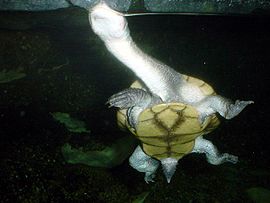- Roti Island snake-necked turtle
-
Roti Island snake-necked turtle Roti Island Snake-necked Turtle Conservation status Scientific classification Kingdom: Animalia Phylum: Chordata Class: Sauropsida Order: Testudines Suborder: Pleurodira Family: Chelidae Subfamily: Chelodininae Genus: Chelodina Species: C. mccordi Binomial name Chelodina mccordi
Rhodin, 1994[1]The Roti Island snake-necked turtle (Chelodina mccordi) is an extremely threatened turtle species from Rote Island south west of Timor between New Guinea and Australia. It belongs to the genus Chelodina (Australian snake-necked turtles) within the family of Side-necked turtles (Chelidae)
Contents
Description
The Roti Island snake-necked turtle was split from the New Guinea snake-necked turtle and regarded as distinct species in 1994 after Dr. Anders Rhodin, director of the Chelonian Research Foundation in Lunenburg (Massachusetts), found out that there are differences between the two species. The first snake-necked turtles on Roti Island were discovered in 1891 by George Albert Boulenger. They were named for Dr. William McCord, a veterinary and turtle expert from Hopewell Junction, New York.
The carapace can reach a length between 18 and 24 centimetres. The length of the neck is similar. The color of the carapace is pale grey brown. Occasionally there are also specimens which have a chestnut coloured hue. The plastron is pale buff white. The neck is dark brown on the upperparts with round tubercles. The underparts are beige white. The iris is black surrounded by a white ring. Its habitat are swamps, rice terraces, and small lakes.
Reproduction
A clutch can consist of eight to fourteen eggs and it can have three breeding periods in one year. The size of the eggs is 30 x 20 mm and the weight can reach eight to ten grams. The first hatchlings come after three months, the last after four months. When they hatch they have a size of 28 x 20 mm and they have yellow spots on the plastron which become darker with the time until the plastron becomes almost black after a few weeks. During the growing period the coloring becomes more pale until they finally reach the color of the adults.
Threats
The Roti Island Snake-necked Turtle is one of the most desired turtles in the international pet trade. Even before it was scientifically described it was so over-collected that the legal trade was prohibited in 2001 due to its rarity. The two or three remaining populations live in an area of only 70 km² in the central highlands of Roti Island. It is still illegally captured and it is often offered on markets under the label of the New Guinea Snake-necked Turtle which is also legally protected. In 2004 it was listed in Appendix II of CITES.
Outside of capture by humans there are few natural threats to this species. There are some reports of predation by feral pigs (Sus Scrofa)[2] and loss of habitat, however illegal capture and trade remains the primary threat.
References
- ^ Rhodin AGJ. 1994b. Chelid turtles of the Australian archipelago: II. A new species of Chelodina from Roti Island, Indonesia. Breviora 498: 1-31.
- ^ World Wildlife WWF-Indonesia TRAFFIC Report
External links
 Media related to Chelodina mccordi at Wikimedia Commons
Media related to Chelodina mccordi at Wikimedia Commons Data related to Chelodina mccordi at Wikispecies
Data related to Chelodina mccordi at Wikispecies- Asian Turtle Trade Working Group 2000. Chelodina mccordi. In: IUCN 2006. 2006 IUCN Red List of Threatened Species. <www.iucnredlist.org>. Downloaded on 27 July 2006. Database entry includes justification for why this species is critically endangered
- Chelodina mccordi (engl.)
- Inclusion of Roti Snake-necked Turtle Chelodina mccordi in Appendix II. Proponents: Indonesia and United States of America. (engl.)
- TRAFFIC - Roti Island Snake-necked Turtles become all but extinct (engl.)
- TRAFFIC - The Trade of the Roti Island Snake-necked Turtle Chelodina mccordi (engl.)
Side-necked turtle species Kingdom: Animalia · Phylum: Chordata · Class: Reptilia · Subclass: Anapsida · Order: Testudines · Suborder: Pleurodira Family Chelidae Chelodininae Chelodina canni · Chelodina longicollis · Chelodina mccordi · Chelodina novaeguineae · Chelodina reimanni · Chelodina steindachneri · Chelodina burrungandjii · Chelodina expansa · Chelodina parkeri · Chelodina rugosa · Chelodina collieiEmydura australis · Emydura macquarii · Emydura signata · Emydura subglobosa · Emydura tanybaraga · Emydura victoriaeMyuchelys latisternum · Myuchelys georgesi · Myuchelys purvisi · Myuchelys belli · Myuchelys novaeguineaePseudemyduraPseudemydura umbrinaRheodytesRheodytes leukopsChelidinae ChelusChelus fimbriatus (Mata mata)Mesoclemmys dahli · Mesoclemmys gibba · Mesoclemmys heliostemma · Mesoclemmys hogei · Mesoclemmys nasuta · Mesoclemmys perplexa · Mesoclemmys raniceps · Mesoclemmys tuberculata · Mesoclemmys vanderhaegei · Mesoclemmys zuliaePhrynops geoffroanus · Phrynops hilarii · Phrynops tuberosus · Phrynops williamsiRhinemysRhinemys_rufipesHydromedusinae Superfamily Pelomedusoidea Pelomedusinae PelomedusaPelomedusa subrufaPelusios adansonii · Pelusios bechuanicus · Pelusios broadleyi · Pelusios carinatus · Pelusios castanaeus · Pelusios castanoides · Pelusios chapini · Pelusios cupulatta · Pelusios gabonensis · Pelusios marani · Pelusios nanus · Pelusios niger · Pelusios rhodesianus · Pelusios sinuatus · Pelusios subniger · Pelusios upembae · Pelusios williamsiPodocnemidinae ErymnochelysErymnochelys madagascariensisPeltocephalusPeltocephalus dumerilianusPodocnemis expansa · Podocnemis unifilis · Podocnemis erythrocephala · Podocnemis lewyana · Podocnemis sextuberculata · Podocnemis vogliCategories:- IUCN Red List critically endangered species
- Reptiles of Indonesia
- Chelodina
Wikimedia Foundation. 2010.



